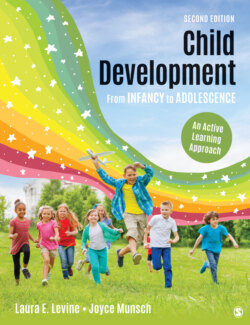Читать книгу Child Development From Infancy to Adolescence - Laura E. Levine - Страница 199
На сайте Литреса книга снята с продажи.
Canalization
ОглавлениеThere is considerable variability in how strongly genes affect different traits or characteristics. The degree to which the expression of a gene is influenced by the environment is captured in the concept of canalization proposed by Conrad Hal Waddington (1942). Imagine yourself looking down from the top of a steep hill. You see that water and weather have carved gullies (or canals) into the hillside. Some are deep and narrow, and others shallow and wide. If you begin rolling balls down the hillside, some will travel down the deep, narrow pathways and end up in about the same place every time, but others will travel down the shallow, wide pathways and may end up on one side or the other of the gully by the time they reach the bottom of the hill (see Figure 3.8).
Canalization: The degree to which the expression of a gene is influenced by the environment.
Description
Figure 3.8 Canalization.
In a similar way, we can think of some traits as being deeply canalized. Genes for deeply canalized traits have a self-righting tendency that produces the expected developmental outcome under all but the most extreme environmental conditions (Black, Hess, & Berenson-Howard, 2000). For example, across a wide spectrum of environmental conditions, almost all infants reach the early motor milestones, like sitting up and walking. In contrast, a trait such as intelligence is much more variable in its outcome. This genetic pathway is less constrained or less deeply canalized, so it is more influenced by the landscape of the child’s environment. Children raised in the relatively enriched environment of middle- and upper-income families are likely to express the levels of intelligence provided by their genetic inheritance, whether that is high, low, or average. However, genetic inheritance plays a smaller role for children raised in low-income families because scarcer high-quality educational opportunities and a host of other risks in their environment limit their development (Blair & Raver, 2012; Tucker-Drob & Bates, 2016).
Children from low-income families can certainly overcome these limitations and express the full range of possibilities provided by their genetic inheritance, but this is more likely to happen if they are provided with environmental resources such as good educational opportunities and healthcare. The concept of canalization thus gives us insight into the complex interaction between our genetic endowment and the influence of the environment. We next describe one mechanism by which canalization occurs: behavioral epigenetics.
Environmental influence on gene expression. In Arlington, VA, a trolley was used to take children from low-income families to their community libraries during the summer. Although poverty can restrict the expression of genes that contribute to intelligence and academic achievement, this range can be expanded with educational opportunities such as these.
The Washington Post / Contributor via Getty images
